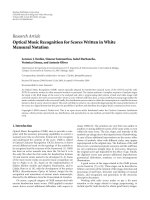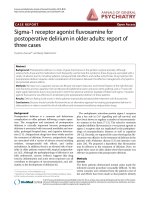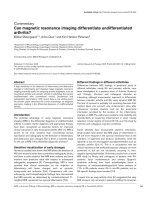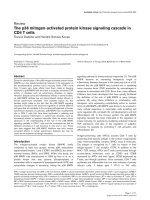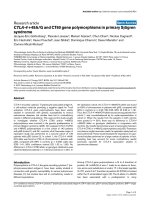Báo cáo y học: "Can performance indicators be used for pedagogic purposes in disaster medicine training?" docx
Bạn đang xem bản rút gọn của tài liệu. Xem và tải ngay bản đầy đủ của tài liệu tại đây (311.62 KB, 5 trang )
BioMed Central
Page 1 of 5
(page number not for citation purposes)
Scandinavian Journal of Trauma,
Resuscitation and Emergency Medicine
Open Access
Original research
Can performance indicators be used for pedagogic purposes in
disaster medicine training?
Masahiro Wakasugi*
1,2
, Heléne Nilsson
1
, Johan Hornwall
1
, Tore Vikström
1
and Anders Rüter
1
Address:
1
Centre for Teaching and Research in Disaster Medicine and Traumatology, Faculty of Health Sciences, Department of Clinical and
Experimental Medicine, University Hospital, S581 85 Linköping, Sweden and
2
Department of Emergency and Disaster Medicine, Graduated
School of Medicine, University of Toyama, 930-0194 Sugitani 2630, Toyama, Japan
Email: Masahiro Wakasugi* - ; Heléne Nilsson - ; Johan Hornwall - ;
Tore Vikström - ; Anders Rüter -
* Corresponding author
Abstract
Background: Although disaster simulation trainings were widely used to test hospital disaster
plans and train medical staff, the teaching performance of the instructors in disaster medicine
training has never been evaluated. The aim of this study was to determine whether the
performance indicators for measuring educational skill in disaster medicine training could indicate
issues that needed improvement.
Methods: The educational skills of 15 groups attending disaster medicine instructor courses were
evaluated using 13 measurable performance indicators. The results of each indicator were scored
at 0, 1 or 2 according to the teaching performance.
Results: The total summed scores ranged from 17 to 26 with a mean of 22.67. Three indicators:
'Design', 'Goal' and 'Target group' received the maximum scores. Indicators concerning running
exercises had significantly lower scores as compared to others.
Conclusion: Performance indicators could point out the weakness area of instructors' educational
skills. Performance indicators can be used effectively for pedagogic purposes.
Background
Disaster simulation trainings are considered as the tradi-
tional method of testing hospital disaster plans and train-
ing medical staff, and are widely used throughout the
world [1-5]. However, it is still unclear whether these exer-
cises are effective in improving the healthcare provider's
skill in disaster response. One reason for this maybe that
there is no generally accepted methodology for a quanti-
tative evaluation of these disaster trainings and no scien-
tific evidence of their effectiveness on the healthcare
provider's knowledge and skills in disaster response [6].
We have previously introduced and revealed the validity
of the performance indicators as a fundamental tool for
evaluation and quality control of the staff disaster man-
agement skills [7-10]. Measurable performance indicators
could be used in training management, command and
control at different levels of major incidents and disasters.
Published: 17 March 2009
Scandinavian Journal of Trauma, Resuscitation and Emergency Medicine 2009, 17:15 doi:10.1186/1757-7241-
17-15
Received: 5 November 2008
Accepted: 17 March 2009
This article is available from: />© 2009 Wakasugi et al; licensee BioMed Central Ltd.
This is an Open Access article distributed under the terms of the Creative Commons Attribution License ( />),
which permits unrestricted use, distribution, and reproduction in any medium, provided the original work is properly cited.
Scandinavian Journal of Trauma, Resuscitation and Emergency Medicine 2009, 17:15 />Page 2 of 5
(page number not for citation purposes)
Well-defined performance indicators assure a fair and
unbiased determination of the efficacy of educational
methods for disaster medicine training.
Now that we have acquired the tool for testing our educa-
tional impact, we have a new question: how do we
improve the education methods to achieve more teaching
effectiveness? Faculty and staff development has become
an increasingly important component of medical educa-
tion and there is an expanding body of literature to exam-
ine the effectiveness of the faculty development course
[11,12]. However, to the extent of our knowledge, there
are few studies concerning faculty development in disaster
medicine [13] and no reports that evaluate the teaching
performance of instructors in disaster medicine training.
Well-trained instructors are essential for conducting effec-
tive disaster medicine training. How can we assess
whether instructors have good educational skills? This
would be possible if a precise scale, or defined perform-
ance indicators for evaluating teaching performance, were
established. Thus, the objective of our study was to evalu-
ate whether a postulated set of performance indicators for
measuring the teaching skills of instructors in a disaster
medicine simulation training course could reveal those
parts of education and training that needed improvement.
Methods
Results from the final examinations of 15 groups partici-
pating in a three-day long disaster medicine instructor
course were included [14]. The training course was con-
ducted from 2005–2008 by an international training cen-
tre and students from 15 different countries registered for
it. The training tool used was the Emergo Train System
®
,
which is an educational tool consisting of magnetic sym-
bols on white boards; these symbols represent patients,
staff and resources, while movable markers are used indi-
cate priority and treatment and a large patient bank with
protocol giving the results of treatments based on a
trauma score agreed on in Sweden [15].
All students received theoretical and practical training in
setting up, running, and evaluating simulation exercises.
In the role-play simulation exercises, students were
divided into small groups consisting of 2–5 students each
and the groups were mixed with regard to the nationalities
of the students. One group performed as 'instructors' dur-
ing an exercise and the other students performed as the
target 'students' group. When the exercise was completed,
the group members changed roles and trained again. Dur-
ing the role-play exercises, the 'students' groups played the
role of average students, not pretending to be extremely
bright or poor students. The last of the three exercises in
the course was considered as the final exam that we eval-
uated for this study; the complexity of content and level of
difficulty is of this final exercise was higher than those of
the first two. The time for setting up the last exercise was
three hours, and one hour was allotted for conducting the
exercise, including the assessment and feedback.
All the exercises were evaluated according to a template
with 13 measurable performance indicators (Table 1).
These performance indicators were established as a result
of our several years experience conducting instructor
training courses. Items were chosen to judge the compe-
tencies of trainers in preparing, executing and evaluating
skills and knowledge for disaster medicine training. The
results were scored as 0, 1 or 2 according to the perform-
ance of the 'instructors' group (not scored for individual
participants). The maximum possible total score was 26
points for each of the groups. All groups were evaluated by
the same persons (the authors of this paper). To avoid
inter-rater discrepancies, we standardised the criteria for
grading the performance indicators before this study.
Throughout the study, one rater was responsible for scor-
ing all the groups of the course. All performances that
were evaluated had been previously demonstrated and
lectured on to students.
The statistical method used was Analysis of Variance and
the post-hoc Tukey test was used to undertake compari-
sons in pairs. P < 0.05 was considered as significant.
Results
All the 13 indicators were evaluated appropriately for the
15 groups. The total summed indicators' scores for each of
the simulation exercise ranged from 17 to 26 out of 26
with a mean of 22.67. The median of the summed per-
formance indicators' score was 23. The median values of
each evaluated indicator varied from 1.00 to 2.00 out of 2.
The value of Cronbach's alpha of the performance indica-
tors was 0.87.
All groups achieved full scores on the three indicators: 1.
Design, 4. Goal and 8. Target group (Table 2). The two worst
scored indicators (9. Interventions and 10. Time out) signif-
icantly differed from the other indicators (Figure 1).
Discussion
Although the need to provide training for faculty develop-
ment to improve the teaching skills of instructors is
increasingly recognized in many medical areas [16], their
impact has not yet been established. To the extent of our
knowledge, there are some studies concerning the useful-
ness of instructor training in the trauma care education
course [17,18]; however, no study has evaluated the
impact of the educator's pedagogic skills in disaster med-
icine. In order to verify the correlation between educator's
skill and educational effect for students, it would be nec-
essary to create an objective scale to compare the teaching
skill of educators. Thus, for a start, we planned to develop
the assessment tools for measuring the educators' teach-
ing skills. We had previously reported the usefulness and
Scandinavian Journal of Trauma, Resuscitation and Emergency Medicine 2009, 17:15 />Page 3 of 5
(page number not for citation purposes)
Table 1: Proposed performance indicators used in this study, evaluation criteria and points
Indicators Explanation and comments
1. Design 0 = No clear design
1 = Clearly described too small or too extensive
2 = Good
2. Running simulation 0 = No enthusiasm
1 = Enthusiastic but not with control
2 = Enthusiastic and in control
3. Aim 0 = Unclear
1 = Clear but not patient related
2 = Clear and patient related
4. Goal 0 = Not relevant
1 = Relevant but not understandable
2 = Relevant and understandable
5. Objectives 0 = Not stated
1 = Stated but not measurable
2 = Stated and measurable
6. Performance indicators 0 = Not realistic
1 = Realistic but no challenge
2 = Realistic and challengeable
7. Target level 0 = Not defined
1 = Defined but not followed
2 = Defined and followed
8. Target group 0 = Not defined
1 = Defined but not adopted to
2 = Defined and adopted to
9. Interventions 0 = No or unclear purpose of interventions
1 = Clear purpose, poorly executed and/or followed up
2 = Clear purpose, good executed and followed up
10. Time-out 0 = No start or no stop
1 = Start and stop no purpose
2 = Start/Stop/Purpose
11. Evaluation 0 = Not using performance indicators (p.i.)
1 = Using p.i. Not precise enough
2 = Using p.i Being specific
12. Feedback 0 = No feed back
1 = No suggestions on how to improve
2 = Good feed back, good suggestions
13. Overall impression 0 =
1 =
2 =
Scandinavian Journal of Trauma, Resuscitation and Emergency Medicine 2009, 17:15 />Page 4 of 5
(page number not for citation purposes)
effectiveness of performance indicators in evaluating the
staff skills during disaster medicine training [7-10]. The
same approach could be used to compare the teaching
skills quantitatively. Therefore, in this study, we evaluated
the educational skills of the participants in the disaster
medicine instructor training course by using postulated
performance indicators. The indicators used in this study
were established based on the results of our experience of
the disaster medicine instructor training sessions.
This study elucidated the issues regarding improvements
after conducting disaster medicine trainings. The instruc-
tor roles for disaster medicine simulation training would
be divided into the following three parts. The first part
would involve designing the exercise scenario to achieve
objectives that were defined clearly and adequately to par-
ticipants. Next, based on these scenarios, instructors had
to conduct the simulation exercise. They introduced the
exercise settings and periodically interjected updates,
which we referred to as interventions; furthermore,
instructors also encouraged participants to discuss
focused issues and make decisions within a limited time.
Evaluations and feedback were the last task for instructors.
They were the key to stimulate the learning process and
inform students about their strengths and weak areas that
needed improvement. Reviewing results could transform
the lessons observed into lessons learned. The perform-
ance indicators, as we previously reported, could be used
to assess the participants' skills objectively and would
assist in giving adequate feedback.
We have chosen performance indicator items in order to
be able to evaluate the instructor's skills in the categories
of design, execution and evaluation. When we try to apply
these categories to the results of this study, fully scored
performance indicators would be categorized to the first
category that concern preparation for exercises. The
designing of the exercise and setting the goal of the
adopted exercise to the target group and level were well
organized. Although the results fell short of a perfect
score, the indicators concerning evaluation and feedback
had a relatively favourable grade. Meanwhile, indicators
of Time out and Interventions had significantly worse
results than others, as it was more difficult for instructors
to conduct and control the simulation exercise properly
than other missions such as preparation and evaluation.
Training skills requiring expertise in real time interactive
methods are less developed than others. To improve the
teaching skills of instructors, remediation efforts in this
aspect are required. Several possible solutions could be
considered for this issue; one is that training the faculty as
disaster medicine instructors should be lesson learned,
same as the disaster medicine training itself, not lesson
observed. Procedural skills are considered to demand a
longer practice time than psychomotor skills [19].
Although the techniques and knowledge to design exer-
cises can be obtained from classroom lectures, the skills to
Table 2: Average score of each performance indicator of 15
groups
Performance Indicators Average Score
1. Design 2.00
2. Running simulation 1.87
3. Aim 1.67
4. Goal 2.00
5. Objectives 1.80
6. Performance indicators 1.87
7. Target level 1.93
8. Target group 2.00
9. Interventions 1.20
10. Time outs 1.00
11. Evaluation 1.73
12. Feedback 1.73
13. Overall impression 1.87
Total Average Score 22.67
Comparison of results from 13 different performance indicatorsFigure 1
Comparison of results from 13 different performance indicators. The mean values of the 13 indicators are on the
base line. The numbers of each performance indicators are circled. Numbers that lie below the same horizontal line do not
have a significant difference (p < 0.05).
㽺
㽻
㽺
㽻
㽲
㽳
㽴
㽵
㽶
㽷
㽸
㽹
㽼
㽽
㽾
㽲
㽳
㽴
㽶
㽸
㽼
Scandinavian Journal of Trauma, Resuscitation and Emergency Medicine 2009, 17:15 />Page 5 of 5
(page number not for citation purposes)
conduct and facilitate simulation exercises favourably
may need to be learned from substantial experience. These
demanding skills may be regarded as general educational
skills rather than specific skills for disaster medicine train-
ing and need a fair amount of educational experimenta-
tion. Further study to compare the results after
modification of the faculty development will elucidate
this point.
Several limitations of this study should be acknowledged.
First, the reliability and validity of the performance indi-
cators need to be considered. Performance indicators in
this study were chosen from our experience and lack of
strict evidence. Cronbach's alpha, calculated to estimate
the reliability, was of an adequately high value to rely on
the indicators and we had taken content validity into con-
sideration when choosing the indicator items. However,
relationships between the student performance and the
education skill of the instructors are our major concern,
and future studies to compare these may be needed to val-
idate the performance indicators.
The sensitivity of our performance indicators is the next
drawback. Many 'instructors' groups performed well in
this study. The majority got a very high score against many
of the performance indicators. This may suggest that the
postulated performance indicators lack the power to point
out the weakness of the instructors' group. Although from
another point of view, the reason is that the challenges in
this study could have been fairly simple for the 'instruc-
tors' groups. This study was conducted as part of a role-
play exercise in the instructor training course, different
from the usual settings. Participants who acted as 'stu-
dents' were knowledgeable persons who knew the simula-
tor training system very well. Therefore, we could neither
evaluate the primary learning outcome of the trainees nor
check the correlation between the instructional skill and
the educational impact. The ultimate purpose of the disas-
ter medicine training is to improve patient outcomes as a
result of the training program. We are planning another
study to elucidate a relation between instructor perform-
ance as measured by performance indicators and student
performance in a regular disaster training course.
Conclusion
In conclusion, the performance indicators set in this study
could point out the weakness areas of instructors that
needed improvement. Future studies may reveal the corre-
lations between the teaching skills of instructors and the
educational impact of trainees in disaster medicine train-
ing. Performance indicators could be used effectively for
pedagogic purposes.
Competing interests
The authors declare that they have no competing interests.
Authors' contributions
MW drafted the manuscript, participated in the litterateur
search, and in data interpretation. HN and JH participated
in data collection and interpretation, TV is head of the
Centre for teaching and research in disaster medicine and
traumatology, revised the manuscript, and participated in
data collection and interpretation. AR conceived of the
study and participated in its design and coordination and
helped to draft the manuscript. All authors read and
approved the final manuscript.
References
1. Kaji AH, Langford V, Lewis RJ: Assessing hospital disaster pre-
paredness: A comparison of an on-site survey, directly
observed drill performance, and video analysis of teamwork.
Ann Emerg Med 2008, 52:195-201.
2. Kaji AH, Lewis RJ: Assessment of the Johns Hopkins/AHRQ
hospital disaster drill evaluation tool. Ann Emerg Med 2008,
52:204-210.
3. Bartley BH, Stella JB, Walsh LD: What a disaster?! Assessing util-
ity of simulated disaster exercise and educational process for
improving hospital preparedness. Prehosp Disast Med 2006,
21:249-255.
4. Klein KR, Brandenburg DC, Atas JG, Maher A: The use of trained
observers as an evaluation tool for a multi-hospital bioter-
rorism exercise. Prehosp Disaster Med 2005, 20(3):159-163.
5. Gebbie KM, Valas J, Merrill J, Morse S: Role of exercises and drills
in the evaluation of public health in emergency response. Pre-
hosp Disaster Med 2006, 21:173-182.
6. Lennquist S: Promotion of disaster medicine to a scientific dis-
cipline – A slow and painful, but necessary process. Interna-
tional Journal of Disaster Medicine 2003, 1:95-96.
7. Rüter A, Örtenwall P, Vikström T: Staff procedure skills in man-
agement groups during exercises in disaster medicine. Pre-
hosp Disaster Med 2007, 22(4):318-321.
8. Rüter A, Örtenwall P, Vikström T: Performance indicators for
major incident medical management – A possible tool for
quality control? International Journal of Disaster Medicine 2004,
2:52-55.
9. Rüter A, Nilsson H, Vikström T: Performance indicators as qual-
ity control for testing and evaluating hospital management
groups: a pilot study. Prehosp Disast Med 2006, 21:423-426.
10. Rüter A, Örtenwall P, Vikström T: Performance indicators for
prehospital command and control in training of medical first
responders. International Journal of Disaster Medicine 2004, 2:89-92.
11. Murphy AM, Neequaye S, Kreckier S, Hands JL: Should we train
the trainers? Results of randomized trial.
J Am Coll Surg 2008,
207:185-190.
12. Clark JM, Houston TK, Kolodner K, Branch WT, Lecine RB, Kern DE:
Teaching the teachers National survey of faculty develop-
ment in departments of medicine of U.S. teaching hospitals.
J Gen Intern Med 2004, 19:205-214.
13. Bradt DA, Abraham K, Franks R: A strategic plan for disaster
medicine in Australasia. Emerg Med (Fremantle) 2003,
15:271-282.
14. Emergo Train System, Senior instructor course [http://
www.emergotrain.com/Products/ETSSeniorInstructor/tabid/67/
Default.aspx]
15. Emergo Train System [ />tabid/65/Default.aspx]
16. Notzer N, Abramovitz R: Can brief workshops improve clinical
instruction? Med Educ 2008, 42:152-156.
17. Kilroy DA: Teaching the trauma teachers: an international
review of the Advanced Trauma Life Support Instructor
Course. Emerg Med J 2007, 24:467-470.
18. Moss GD: Advanced Trauma Life Support instructor training
in the UK: an evaluation. Postgrad Med J 1998, 74:220-224.
19. Ginzburg S, Dar-El EM: Skill retention and relearning – a pro-
posed cyclical model. J Workplace Learning 2000, 12:327-332.

